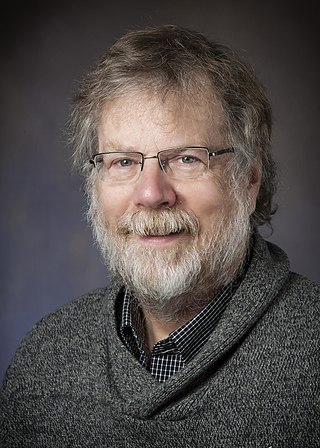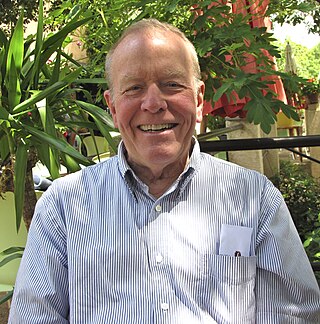Related Research Articles

In physics, lattice gauge theory is the study of gauge theories on a spacetime that has been discretized into a lattice.

Lattice QCD is a well-established non-perturbative approach to solving the quantum chromodynamics (QCD) theory of quarks and gluons. It is a lattice gauge theory formulated on a grid or lattice of points in space and time. When the size of the lattice is taken infinitely large and its sites infinitesimally close to each other, the continuum QCD is recovered.
Parallel tempering, in physics and statistics, is a computer simulation method typically used to find the lowest energy state of a system of many interacting particles. It addresses the problem that at high temperatures, one may have a stable state different from low temperature, whereas simulations at low temperatures may become "stuck" in a metastable state. It does this by using the fact that the high temperature simulation may visit states typical of both stable and metastable low temperature states.
Quantum Monte Carlo encompasses a large family of computational methods whose common aim is the study of complex quantum systems. One of the major goals of these approaches is to provide a reliable solution of the quantum many-body problem. The diverse flavors of quantum Monte Carlo approaches all share the common use of the Monte Carlo method to handle the multi-dimensional integrals that arise in the different formulations of the many-body problem.
Ab initio quantum chemistry methods are computational chemistry methods based on quantum chemistry. The term ab initio was first used in quantum chemistry by Robert Parr and coworkers, including David Craig in a semiempirical study on the excited states of benzene. The background is described by Parr. Ab initio means "from first principles" or "from the beginning", implying that the only inputs into an ab initio calculation are physical constants. Ab initio quantum chemistry methods attempt to solve the electronic Schrödinger equation given the positions of the nuclei and the number of electrons in order to yield useful information such as electron densities, energies and other properties of the system. The ability to run these calculations has enabled theoretical chemists to solve a range of problems and their importance is highlighted by the awarding of the Nobel prize to John Pople and Walter Kohn.
Auxiliary-field Monte Carlo is a method that allows the calculation, by use of Monte Carlo techniques, of averages of operators in many-body quantum mechanical or classical problems.

In computational chemistry, a water model is used to simulate and thermodynamically calculate water clusters, liquid water, and aqueous solutions with explicit solvent. The models are determined from quantum mechanics, molecular mechanics, experimental results, and these combinations. To imitate a specific nature of molecules, many types of models have been developed. In general, these can be classified by the following three points; (i) the number of interaction points called site, (ii) whether the model is rigid or flexible, (iii) whether the model includes polarization effects.
In computational physics, variational Monte Carlo (VMC) is a quantum Monte Carlo method that applies the variational method to approximate the ground state of a quantum system.

Positron annihilation spectroscopy (PAS) or sometimes specifically referred to as positron annihilation lifetime spectroscopy (PALS) is a non-destructive spectroscopy technique to study voids and defects in solids.
In applied mathematics, the numerical sign problem is the problem of numerically evaluating the integral of a highly oscillatory function of a large number of variables. Numerical methods fail because of the near-cancellation of the positive and negative contributions to the integral. Each has to be integrated to very high precision in order for their difference to be obtained with useful accuracy.
A field-theoretic simulation is a numerical strategy to calculate structure and physical properties of a many-particle system within the framework of a statistical field theory, like e.g. a polymer field theory. A convenient possibility is to use Monte Carlo (MC) algorithms, to sample the full partition function integral expressed in field-theoretic representation. The procedure is then called the auxiliary field Monte Carlo method. However, it is well known that MC sampling in conjunction with the basic field-theoretic representation of the partition function integral, directly obtained via the Hubbard-Stratonovich transformation, is impracticable, due to the so-called numerical sign problem. The difficulty is related to the complex and oscillatory nature of the resulting distribution function, which causes a bad statistical convergence of the ensemble averages of the desired structural and thermodynamic quantities. In such cases special analytical and numerical techniques are required to accelerate the statistical convergence of the field-theoretic simulation.

CP2K is a freely available (GPL) quantum chemistry and solid state physics program package, written in Fortran 2008, to perform atomistic simulations of solid state, liquid, molecular, periodic, material, crystal, and biological systems. It provides a general framework for different methods: density functional theory (DFT) using a mixed Gaussian and plane waves approach (GPW) via LDA, GGA, MP2, or RPA levels of theory, classical pair and many-body potentials, semi-empirical and tight-binding Hamiltonians, as well as Quantum Mechanics/Molecular Mechanics (QM/MM) hybrid schemes relying on the Gaussian Expansion of the Electrostatic Potential (GEEP). The Gaussian and Augmented Plane Waves method (GAPW) as an extension of the GPW method allows for all-electron calculations. CP2K can do simulations of molecular dynamics, metadynamics, Monte Carlo, Ehrenfest dynamics, vibrational analysis, core level spectroscopy, energy minimization, and transition state optimization using NEB or dimer method.
This is a list of notable computer programs that are used for nucleic acids simulations.

David Matthew Ceperley is a theoretical physicist in the physics department at the University of Illinois Urbana-Champaign or UIUC. He is a world expert in the area of Quantum Monte Carlo computations, a method of calculation that is generally recognised to provide accurate quantitative results for many-body problems described by quantum mechanics.
The following timeline starts with the invention of the modern computer in the late interwar period.
Path integral molecular dynamics (PIMD) is a method of incorporating quantum mechanics into molecular dynamics simulations using Feynman path integrals. In PIMD, one uses the Born–Oppenheimer approximation to separate the wavefunction into a nuclear part and an electronic part. The nuclei are treated quantum mechanically by mapping each quantum nucleus onto a classical system of several fictitious particles connected by springs governed by an effective Hamiltonian, which is derived from Feynman's path integral. The resulting classical system, although complex, can be solved relatively quickly. There are now a number of commonly used condensed matter computer simulation techniques that make use of the path integral formulation including Centroid Molecular Dynamics (CMD), Ring Polymer Molecular Dynamics (RPMD), and the Feynman-Kleinert Quasi-Classical Wigner (FK-QCW) method. The same techniques are also used in path integral Monte Carlo (PIMC).

James Bernhard Anderson was an American chemist and physicist. From 1995 to 2014 he was Evan Pugh Professor of Chemistry and Physics at the Pennsylvania State University. He specialized in Quantum Chemistry by Monte Carlo methods, molecular dynamics of reactive collisions, kinetics and mechanisms of gas phase reactions, and rare-event theory.

Ali Alavi FRS is a professor of theoretical chemistry in the Department of Chemistry at the University of Cambridge and a Director of the Max Planck Institute for Solid State Research in Stuttgart.

Massimo Boninsegni is an Italian-Canadian theoretical condensed matter physicist. He graduated with a Bachelor's degree in physics at the Universita' degli Studi di Genova in 1986.
References
- ↑ Barker, J. A. (1979). "A quantum-statistical Monte Carlo method; path integrals with boundary conditions". The Journal of Chemical Physics. 70 (6): 2914–2918. Bibcode:1979JChPh..70.2914B. doi:10.1063/1.437829.
- ↑ Cazorla, Claudio; Boronat, Jordi (2017). "Simulation and understanding of atomic and molecular quantum crystals". Reviews of Modern Physics. 89 (3): 035003. arXiv: 1605.05820 . Bibcode:2017RvMP...89c5003C. doi:10.1103/RevModPhys.89.035003 . Retrieved May 13, 2022.
- ↑ Topper, Robert Q. (1999). "Adaptive path-integral Monte Carlo methods for accurate computation of molecular thermodynamic properties". Advances in Chemical Physics. 105: 117–170. Retrieved May 12, 2022.
- ↑ Glaesemann, Kurt R.; Fried, Laurence E. (2002). "An improved thermodynamic energy estimator for path integral simulations". The Journal of Chemical Physics. 116 (14): 5951–5955. Bibcode:2002JChPh.116.5951G. doi:10.1063/1.1460861.
- 1 2 Glaesemann, Kurt R.; Fried, Laurence E. (2002). "Improved heat capacity estimator for path integral simulations". The Journal of Chemical Physics. 117 (7): 3020–3026. Bibcode:2002JChPh.117.3020G. doi:10.1063/1.1493184.
- 1 2 Glaesemann, Kurt R.; Fried, Laurence E. (2003). "A path integral approach to molecular thermochemistry". The Journal of Chemical Physics. 118 (4): 1596–1602. Bibcode:2003JChPh.118.1596G. doi:10.1063/1.1529682.
- ↑ Glaesemann, Kurt R.; Fried, Laurence E. (2005). "Quantitative molecular thermochemistry based on path integrals". The Journal of Chemical Physics (Submitted manuscript). 123 (3): 034103. Bibcode:2005JChPh.123c4103G. doi: 10.1063/1.1954771 . PMID 16080726.
- ↑ Doll, J.D. (1998). "Monte Carlo Fourier path integral methods in chemical dynamics". Journal of Chemical Physics. 81 (8): 3536. doi:10.1063/1.448081 . Retrieved May 13, 2022.
- ↑ Feynman, Richard P.; Hibbs, Albert R. (1965). Quantum Mechanics and Path Integrals. New York: McGraw-Hill.
- ↑ Wang, Q.; Johnson, J. K.; Broughton, J. Q. (1997). "Path integral grand canonical Monte Carlo". The Journal of Chemical Physics. 107 (13): 5108–5117. Bibcode:1997JChPh.107.5108W. doi:10.1063/1.474874.
- ↑ Freeman, David L; Doll, J. D (1994). "Fourier path integral Monte Carlo method for the calculation of the microcanonical density of states". The Journal of Chemical Physics. 101 (1): 848. arXiv: chem-ph/9403001 . Bibcode:1994JChPh.101..848F. CiteSeerX 10.1.1.342.765 . doi:10.1063/1.468087. S2CID 15896126.
- ↑ Shumway, J.; Ceperley, D.M. (2000). "Path integral Monte Carlo simulations for fermion systems : Pairing in the electron-hole plasma". J. Phys. IV France. 10: 3–16. arXiv: cond-mat/9909434 . doi:10.1051/jp4:2000501. S2CID 14845299 . Retrieved May 13, 2022.
- ↑ Dornheim, Tobias (2020). "Path-integral Monte Carlo simulations of quantum dipole systems in traps: Superfluidity, quantum statistics, and structural properties". Physical Review A. 102 (2): 023307. arXiv: 2005.03881 . Bibcode:2020PhRvA.102b3307D. doi:10.1103/PhysRevA.102.023307. S2CID 218570984 . Retrieved May 13, 2022.
- ↑ Ceperley, D. M. (1995). "Path integrals in the theory of condensed helium". Reviews of Modern Physics. 67 (2): 279–355. Bibcode:1995RvMP...67..279C. doi:10.1103/RevModPhys.67.279.
- ↑ Noya, Eva G.; Sese, Luis M.; Ramierez, Rafael; McBride, Carl; Conde, Maria M.; Vega, Carlos (2011). "Path integral Monte Carlo simulations for rigid rotors and their application to water". Molecular Physics. 109 (1): 149–168. arXiv: 1012.2310 . Bibcode:2011MolPh.109..149N. doi:10.1080/00268976.2010.528202. S2CID 44166408 . Retrieved May 12, 2022.
- ↑ Wallqvist, A; Thirumalai, D.; Berne, B.J. (1987). "Path integral Monte Carlo study of the hydrated electron". Journal of Chemical Physics. 86 (11): 6404. Bibcode:1987JChPh..86.6404W. doi:10.1063/1.452429 . Retrieved May 12, 2022.
- ↑ Capuozzo, Pietro; Panella, Emanuele; Gherardini, Tancredi Schettini; Vvedensky, Dmitri D. (2021). "Path integral Monte Carlo method for option pricing". Physica A: Statistical Mechanics and Its Applications. 581: 126231. Bibcode:2021PhyA..58126231C. doi:10.1016/j.physa.2021.126231 . Retrieved May 13, 2022.